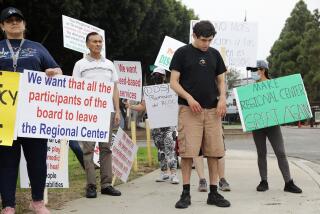Alzheimer’s--Researchers Are Groping to Find a Starting Place
Alzheimer’s disease is the nation’s most frequent cause of dementia, which is characterized by loss of memory and deterioration of all mental functions. Yet, there is no definitive diagnostic test, no specific treatment and no known cause for the disease.
And just how far researchers have to go was clearly underlined last week at a symposium at UCLA before a state Task Force on Alzheimer’s Disease.
The meeting was called to consider the role of California in financing and promoting research in Alzheimer’s above and beyond what the federal government and private organizations are doing.
An estimated 225,000 Californians--about 15% of all residents over 65--have Alzheimer’s, according to participants at the meeting, and the number is expected to increase significantly as the proportion of people in the over-65 age group grows.
After a morning-long session in which invited scientists told the task force about their research interests in the disease, it was also obvious that the state would be able to finance only a fraction of the scientific projects that were suggested.
‘Different Approaches’
“We all agree that the most important thing is to find a cure and a preventive, but . . . there are many different approaches and we can’t predict which one will be right,” said Dr. Lissy Jarvik, a geriatrics specialist at UCLA Medical School and the task force’s research chairman.
One of the dilemmas faced by the task force is to determine the priorities that should be given to the financing of different kinds of research. Is basic research that is aimed, for example, at finding the cause of Alzheimer’s or a good diagnostic test more important than projects that would provide needed social and educational services to help patients who are already stricken?
While several researchers who addressed the group expressed the need for supporting both basic and clinical investigations, most of them advocated one approach or the other.
“I have a healthy skepticism for the discovery of any ‘magic bullet,’ ” said Dr. Jerome A. Yesavage, a Stanford Medical School psychiatrist, referring to the possibility of a quick cure for the disease. The limited financing, he said, would be better spent on finding ways to relieve incontinence, sleep problems and poor nutrition--disabilities that often trouble Alzheimer’s patients.
Biological research is “interesting and sexy,” Yesavage told the task force, but he advised them to “target the dollars where disability has the greatest impact.”
“Incontinence is a terrible problem,” the psychiatrist said, “but who is doing research on it?”
Dr. John P. Blass, director of the Dementia Research Service at Cornell University’s Burke Rehabilitation Center in New York, stressed the need for both biological and clinical care research.
If the state does nothing to finance Alzheimer’s research, he said, it will ultimately end up costing the state through the Medi-Cal program more than the research will cost.
Blass, a longtime Alzheimer’s researcher, said it is becoming clear that inheritance of certain genetic characteristics is the most important risk factor for acquiring the disease.
Recent studies, he said, especially one done in Sweden, have shown that the disease appears to run in families. But studies to pinpoint which gene or genes are involved remain unfulfilled, he said, as does a laboratory test to identify the substance produced genetically that may be the cause of brain cell destruction.
According to the task force chairman, Dr. George G. Glenner, professor of pathology at the University of California, San Diego, the absence of a specific test for Alzheimer’s forces physicians to diagnose the disease by eliminating all other possible causes of dementia, a costly and time-consuming chore.
Diagnostic Blood Test
A report by Glenner in the December issue of the Proceedings of the National Academy of Sciences describes research that he believes may lead to a diagnostic blood test for Alzheimer’s.
The UCSD researcher is attempting to identify a substance in blood that he believes is a precursor of a protein that is found only in the damaged brain cells of Alzheimer’s patients and people with Down’s syndrome. Down’s is a known genetic disease once called mongolism. Glenner speculates that the precursor substance that he believes to be present in blood may be useful as a marker for the genetic trait that leads to Alzheimer’s, and that it may be used to identify individuals who have or will have the disease.
More dollars are needed for all types of Alzheimer’s research, the scientist said in an interview. “The question,” he said, “is how are we going to get the dollars.”
Congressional Money Bill
According to Daniel Maldonado, a task force consultant, federal financing for Alzheimer’s research and social services is $57 million for the current fiscal year. A bill that would appropriate $82 million to states for diagnostic, education, research and other programs is pending in Congress, he said.
California, in the last several years, has shown interest in special programs for patients with the disease. And in September the state Legislature appropriated $1 million to establish eight centers to provide temporary day care for patients so that their relatives who normally take care of them at home can have a day off.
The 11-member state task force was appointed last March to develop recommendations and proposals for future state programs based on information to be obtained during four upcoming hearings in San Francisco, Sacramento and Los Angeles.
The task force’s recommendations are scheduled to go to the Legislature in May, according to Jerry Wenker, an official in the state Department of Aging.










